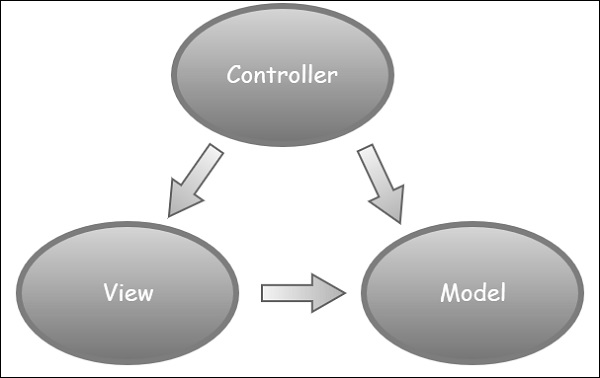
- ASP.NET MVC Tutorial
- ASP.NET MVC - Home
- ASP.NET MVC - Overview
- ASP.NET MVC - Pattern
- ASP.NET MVC - Environment Setup
- ASP.NET MVC - Getting Started
- ASP.NET MVC - Life Cycle
- ASP.NET MVC - Routing
- ASP.NET MVC - Controllers
- ASP.NET MVC - Actions
- ASP.NET MVC - Filters
- ASP.NET MVC - Selectors
- ASP.NET MVC - Views
- ASP.NET MVC - Data Model
- ASP.NET MVC - Helpers
- ASP.NET MVC - Model Binding
- ASP.NET MVC - Databases
- ASP.NET MVC - Validation
- ASP.NET MVC - Security
- ASP.NET MVC - Caching
- ASP.NET MVC - Razor
- ASP.NET MVC - Data Annotations
- Nuget Package Management
- ASP.NET MVC - Web API
- ASP.NET MVC - Scaffolding
- ASP.NET MVC - Bootstrap
- ASP.NET MVC - Unit Testing
- ASP.NET MVC - Deployment
- ASP.NET MVC - Self-hosting
- ASP.NET MVC Useful Resources
- ASP.NET MVC - Quick Guide
- ASP.NET MVC - Useful Resources
- ASP.NET MVC - Discussion
ASP.NET MVC - Pattern
The MVC (Model-View-Controller) design pattern has actually been around for a few decades, and it's been used across many different technologies. Everything from Smalltalk to C++ to Java, and now C Sharp and .NET use this design pattern to build a user interface.
Following are some salient features of the MVC pattern −
Originally it was named Thing-Model-View-Editor in 1979, and then it was later simplified to Model- View-Controller.
It is a powerful and elegant means of separating concerns within an application (for example, separating data access logic from display logic) and applies itself extremely well to web applications.
Its explicit separation of concerns does add a small amount of extra complexity to an application’s design, but the extraordinary benefits outweigh the extra effort.
The MVC architectural pattern separates the user interface (UI) of an application into three main parts.

The Model − A set of classes that describes the data you are working with as well as the business logic.
The View − Defines how the application’s UI will be displayed. It is a pure HTML, which decides how the UI is going to look like.
The Controller − A set of classes that handles communication from the user, overall application flow, and application-specific logic.
Idea Behind MVC
The idea is that you'll have a component called the view, which is solely responsible for rendering this user interface whether that be HTML or whether it actually be UI widgets on a desktop application.
The view talks to a model, and that model contains all of the data that the view needs to display. Views generally don't have much logic inside of them at all.
In a web application, the view might not have any code associated with it at all. It might just have HTML and then some expressions of where to take pieces of data from the model and plug them into the correct places inside the HTML template that you've built in the view.
The controller that organizes is everything. When an HTTP request arrives for an MVC application, that request gets routed to a controller, and then it's up to the controller to talk to either the database, the file system, or the model.